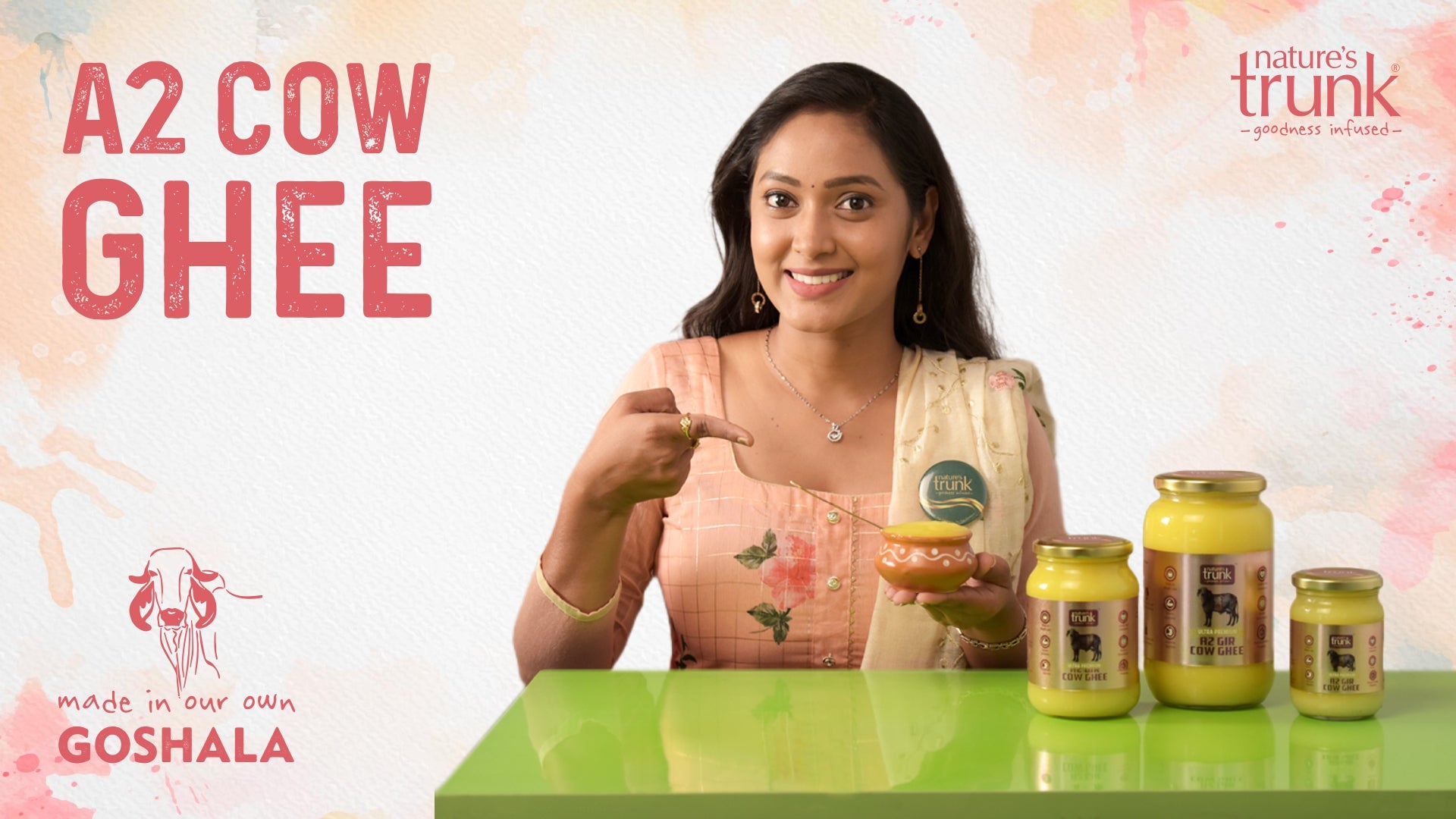Is A2 Cow Ghee really that good for you? The science behind the Hype

Did you know that by 2025, the ghee market can reach £6.1 billion worldwide! Desi Cow Ghee's increasing popularity by its potential health advantages.
Is Cow ghee that good, as everyone says?
We shall look into the science to decide what Cow Ghee does to your health.

Key Notes
- Indian Cuisine has been utilising Cow ghee or clarified butter for centuries.
- With its high amounts of antioxidants, vitamins, and healthy fats in Pure Desi Ghee, it is nutritional addition to any diet.
- Some studies present the view that Cow Ghee may be beneficial for digestion, heart health, and also inflammation. Due to the high calories in clarified butter, it should be used in moderation with a balanced and nutritious diet.
- The Bilona process is believed to be one of the traditional ghee-making processes and has been thought to bring about improvements in the nutritional profile of the product.
Unmasking the Truth about A2 Cow Ghee
Desi Cow Ghee, the golden wonder of Indian cooking, has many numerous benefits and is considered as a healthy elixir. In what ways does Desi Cow ghee vary from butter? By examining how ghee is utilized in Indian cuisine, one will gain a better understanding of this product.
What is Desi Cow Ghee (A2)? How is it different from Butter?
One kind of clarified butter is Ghee. It is made by heating ordinary butter to remove its milk solids and water content. This leaves ghee as a rich, nutty-flavoured fat that is less prone to oxidation. It also contains a higher smoke point compared to butter. This makes it ideal for high-temperature cooking. In India, traditionally extracted ghee in a 'Bilona' process first required the churning of cream by hand to get the butter and then it's simmering. It helps retain the real taste and goodness of pure ghee.
Knowing the Traditional Usage of Cow Ghee in Indian Cuisine
Indian kitchens have traditionally included Cow Ghee as a key ingredient. From curries to sweets to religious rites, it finds one or other way. Its peculiar flavour and aroma add magic to Indian cuisine.
From the traditional variety Bilona Ghee to the best Desi and organic types in India, this Cow Ghee is considered a treasure. It reflected the rich food culture and tradition of India.

The typical use of A2 Cow Ghee in Indian cooking, especially the Bilona method, has crossed boundaries. Be it the best Desi Ghee, Bilona Ghee, or Organic ghee in India, history and benefits have made pure ghee a ‘Sine Qua Non’ in every kitchen.
Is Desi Cow Ghee really that Good for You?
There has been much discussion on the health benefits of Desi Cow Ghee. It's considered a superfood with many medicinal properties by some. Others think it has any nutritional significance. Let's go by science and how good ghee is.
Cardiovascular Health
Ghee is supposed to keep your heart healthy. The special fats in Desi Cow Ghee include CLA and butyrate, which may help with cholesterol and decrease inflammation. However, we would like more studies for confirmation, and ghee consumption must be in moderation.
Weight Management
Some claim that Desi Cow ghee is beneficial for weight loss or control. CLA in Desi Cow Ghee might influence fat metabolism; however, results are inconsistent. A2 Cow Ghee is high in calories and hence should be consumed judiciously, keeping in mind its contribution to one's overall diet if benefits are to be incurred as regards weight.
Healing Properties
A2 Cow Ghee plays a major role in Ayurveda from ancient days. This main Key ingredient has been used to treat a wide range of health disorders, from indigestion to skin issues. However, scientific data supporting these indications is scant, and further studies are required. In short, Desi Cow Ghee is widely debated, whether it is good for health or not. Some studies indicate benefits, but more proof is still required. The best thing is to add A2 Cow Ghee in moderation as part of your diet chart. Always, consult the doctor before making changes in your regular diet.

Nutritional Value per 100g of Desi Cow Ghee

Nutritional Profile
Desi Cow Ghee (Clarified Butter) is originating from India and loved by all health lovers around the globe. It is a pack of special components of healthy fats, vitamins, and compounds that are good for health.
Fat Composition
Desi Cow Ghee is high in healthy fats, specifically monounsaturated and saturated fats. The major contents in the fatty composition of clarified butter include saturated fat, followed by monounsaturated fat and a little polyunsaturated fat. Hence, it is good to include Cow ghee in your regular diet.
Vitamins, Minerals, and other Beneficial Compounds
Bilona Cow Ghee also contains vitamins and minerals equally which help to support your overall growth. As it has vitamins A, D, E, and K, while minerals are calcium, phosphorus, and butyric acid. Hence, Ghee helps to strengthen bones, and best suitable for lactose intolerance people as well.
FAQs
- What is the distinction between any type of ghee and butter?
Unlike ordinary butter, ghee is clarified butter. This means it is always simmered to remove water content and milk solids. What is left behind is golden, rich butterfat that has a higher smoke point, along with a deeper flavour.
- What are the advantages of regularly consuming Desi Cow Ghee?
Pure Desi Cow Ghee is a great source of healthy fats by the name of CLA and omega-3 fatty acids. It is heart-friendly as it prevents weight-gain and combats the inflammation caused by bad pathogens. Similarly, vitamins A, D, E, and K are also present in Bilona processed Ghee to help generally in one's health. But moderation is important.
- Is Desi Cow Ghee lactose-free?
Well, Cow ghee is mostly lactose-free, since the milk solids are taken out in the process of its clarification (Bilona method). Hence, it is very suitable for people suffering from lactose intolerance or on a diet devoid of dairy products.
- How will the application of Cow Ghee be reflected in one's everyday life?
In cooking, Desi Ghee is good for sautéing, stir-frying, and roasting vegetables. And also part of Indian recipes like dals, curries, rice, etc. Try mixing in tea or coffee or on toast or pancakes. In Ayurveda, Cow Ghee plays a major role from ancient days.
- Does Desi Ghee come in different varieties: Organic or Artisanal besides the regular variety?
The difference between regular ghee and organic or artisan ghee does exist. Organic ghee is derived from cows on an organic pasture with no pesticides and synthesized with no chemicals.
Artisan ghees are made by traditional techniques, one of which is the 'Bilona' process. It develops a richer flavour. These ghees would contain, most likely, more nutrients and retain their flavour.
Related articles
Clean eating in a busy Lifestyle: Quick tips that actually works
Do you find yourself too busy to eat? Working late into the night, having meetings one after another, or looking after your family and home can lead you to grab fast food or skip meals altogether. Busy professionals and parents will typically opt for convenience over health. A bag of potato chips, soda, or a candy bar will satisfy you, but they will drain you soon enough. Here's the truth- clean eating doesn't have to be hard. You don't require special cooking gadgets or a lot of meal prep time to eat clean. By strategically making a few small changes, you can power your body significantly without necessarily turning to processed food. Clean eating is really about having better choices in an already busy life. This will provide us with the opportunity to discuss what clean eating is, quick replacements, snack ideas and habits that succeed. Understanding Clean Eating Clean eating is just selecting whole foods which have not been processed, instead of packaged or fake ones. That is, to consume food in a state that's close to the way it grows naturally - fruits, vegetables, grains, nuts, seeds, and lean proteins. For the active, clean eating is more critical. Healthy food gives energy for extended hours, increases focus, and sustains long-term health. Ingesting meals or consuming instant food may give energy in an instant, but usually leads to exhaustion, mood fluctuation, or indigestion. Here is the reality: Clean eating isn't about gourmet diets or high-end recipes. Clean eating is simply an everyday expression of your food choices - it is swapping one bad idea or habit for a better one. Quick Healthy Swaps for Busy People Swap Nuts and Seeds for Chips Chips are laden with empty calories, even though they can be tasty. Not as easy to access but far more filling is a handful of Cashews, Almonds, or Pumpkin seeds. They give you protein and healthy fats that satisfy you longer. Replace Soda and Other Sweetened Beverages with Buttermilk or Infused Water Sugar is abundant in packaged beverages such as soda and juices. Instead, have water flavoured with Mint, Cucumber, or Lemon. Buttermilk, or Chaas, which is consumed in Indian homes, is another cooling, gut-friendly beverage that aids digestion and keeps heat at bay. Replace Dates or Natural Jellies for Chocolate Bars That afternoon, sweet pangs do not have to be unhealthy. Have a box of Dates or Fruit Jellies at hand. They fulfil your sweet pangs naturally and have fiber along with energy. Swap White Rice with Millets or Quinoa White rice is simple to prepare but creates energy dips. Millets or quinoa are preferable overall to eat for lunch or dinner. They are full of fiber, make you feel full, and provide energy in a sustained format that is fabulous with long working hours. Replace with Homemade Dips instead of Creamy Sauces Packaged sauces have tons of preservatives and sugar, too. For dips, I would opt for homemade ones such as hummus, curd-based raita, or homemade chutneys. These are lighter versions that are healthier and taste just as good. Healthy Snacks to Bring on the Go Snacking is probably where working people go wrong with healthy eating. The key to getting this right is to make healthy food that is transportable, tasty, and also easy to prepare. Dried Fruits in Honey: A spoonful of honey-covered almonds, cashews, and figs is a nutritious nut snack that contains energy. Ginger Cubes or Fruit Candies: The following options are helpful for quick relief from indigestion or for when you desire something sweet and tasty. Millet Bars or Porridge Mixes: These contain protein and fiber, and truly are super simple to carry and eat. Fresh Fruits & Nuts: An apple with a tablespoon of peanut butter, or a banana and a small amount of almond butter, is both filling and energizing. With all of these, you will never have to reach for a bag of chips at the office ever again! With these, you'll never need to reach for a packet of chips at the office again. Quick Healthy Habits that last Food is important, but habits are what make you able to stick with it when things get busy. These are some little changes that can make a big difference: Cook for the Week in One Day: Prepare fruits, nuts, or grains in advance to save time. Carry Snack Containers with You: Place small packets of nuts, fruits, or honey blends in your bag. Watch Your Portions: Be filled but not filled to the brim. Have All Your Meals: Skipping meals slows you down and induces you to eat junk food. Rapid Cleansing Beverages: A glass of lemon water or cumin can stimulate your stomach instantly. In Conclusion To Wrap Up, eating clean is not about perfection; it's about improving. Even when you're busy trading chips for nuts or soda for buttermilk, it can alter how your body feels. These habits fuel you with lasting energy, make you concentrate better, and keep you healthy over time. Your wildlife is worth fuelling, not filling. Change one thing today, and you'll notice the difference. Clean, easy eating isn't about doing more - it's about being smarter about what you're eating and easily fitting it into your day.
Is your Gut Healthy? 9 Indian Foods that Soothe Digestion Naturally
After eating, do you often find yourself bloated, heavy, or drained of energy? If your answer is yes, then you are not the only one with this problem. Poor digestion makes that people do not connect the fact that the condition of their gut is directly related to how they feel every day of their lives. Maintaining gut health is not only about staying away from trouble but also about taking in nutrients, creating immunity, and keeping the body in a state of equilibrium. Contemporary diets full of highly processed and chemically-filled foods exert a lot of pressure on the digestive system. The good news is that your kitchen already has some strong remedies for you. For a long time, the traditional Indian ways of cooking have been used to bring back the natural balance and to support digestion. Even the most basic and common ingredients are enough to provide relief from acidity, to comfort your stomach when it is bloated and to augment the strength of your gut. The following are nine Indian superfoods that can help support digestion naturally and provide after-meal comfort. Why Gut Health Matters The term gut health is related to the proper functioning of your digestive tract and the presence of beneficial bacteria that are in the intestines. If your gut is free from any diseases, your body is going to process food faster, digestibility will be higher, and a strong immune system will be maintained. Nevertheless, if the gut is abused with too much junk food, stress, or chemicals, the signs will show, such as acidity, constipation, bloating, and tiredness. Looking after gut health is not all about avoiding issues. Instead, it is about increasing your energy, lifting up your mood and general wellbeing. 9 Indian Foods That Soothe Digestion Naturally 1. Gulkand (Rose Jam) Where used: Gulkand is a post-meal sweet pudding in India. Digestive advantage: It is cool and reduces acid, helping to digest lightly. Instructions: 1 spoon of Gulkand is to be taken at lunch or dinner. Mix it with milk for a sleep aid. 2. Ginger Where it is consumed: Ginger is consumed in Indian teas, Indian curries, and Indian chutneys, among other major components. Gastrointestinal effect: Ginger helps perk up the liver's work of creating digestive enzymes, eliminates the sensation of nausea, and relaxes the stomach air pressure. Directions: To achieve relief quickly, do one of the following- chew a small piece of raw ginger, drink ginger tea. 3. Curd/Yogurt Application: Curd is a highly popular dish in Indian cuisine and is eaten either alone or in the form of raita. Digestive benefit: It is a source of probiotics that help maintain the ratio of good to bad bacteria in the intestines. Instructions: Eat about a small portion of curd with your meals or with roti and sabzi. 4. Jeera (Cumin Seeds) Where and how it is used: It is one of the spices used in cooking curries, rice and drinks. Digestive effect: Jeera improves digestion, eliminates flatulence and rejuvenates metabolism. How to do it: Soak Jeera seeds in water and take them slowly as a hot pot. 5. Ajwain (Carom Seeds) Where it is consumed: Indian snacks, parathas and digestive medicines. Digestive action: clear the stomach of acidity, relieve indigestion, and prevent stomach cramps. Instructions: Warm the teaspoon and burn it with warm water, or roast it a bit and keep it close. 6. Buttermilk (Chaas) Uses: This is taken as a cooler and refreshing drink after meals. Digestive good: Probiotics-infused, quenches thirst, settles the stomach. Usage: Curd mixed with water is used to make a cooling chaas; Jeera powder and salt are added. 7. Banana When it is eaten: The fruit-dinner of Indian homesteads. Digestive benefit: High dietary fiber content, a natural source of prebiotics, which stimulates the increase of bifidobacteria in the intestine. Uses: We eat the ripe banana in the morning or we eat it as a snack in the evening. 8. Fenugreek Seeds (Methi) Where it is used: Fenugreek is the main ingredient of curries, parathas and pickles. Digestive value: High in soluble fiber, which may serve to relieve constipation and keep the bowel well. How to cook: Prepare in advance, soak seeds to eat before breakfast or acquire seeds and curries. 9. Tulsi (Holy Basil) Another application: Ayurvedic drugs and herbal teas. Digestive advantage: Anti-inflammatory, a contribution to stomach infections, and relieves bloating. Dosage: Fresh leaves can be consumed as tea, or one can swallow them to reach optimum results. Your bowels will pay you with better health, more vitality, and ease each day. Everyday Tips for a Healthy Gut True to these foods, digestion can be adjusted by simple habits: · Meals must be eaten on time. Irregular eating can throw the digestive system off. · Eliminate processed food and extra sugar intake. They disturb the balance of the gut bacteria. · Eat fiber and probiotics. Daily fruits, veggies, and yogurt are a must. · Keep yourself well hydrated. Water facilitates easy digestion. · Chew thoroughly and eat attentively. These tiny steps can have a huge impact. Conclusion The maintenance of great gut health forms the basis of total wellness. From reducing bloating to strengthening the immune system, the digestive organs impact every aspect of life. Want to know something even better? Complex dieting isn’t necessary-your Indian kitchen is full of efficient remedies such as Gulkand, Ginger, Cumin, and Buttermilk. You can naturally nurture your gut health through minor, consistent changes and by incorporating these foods into your daily diet. The next time you are feeling heavy or in discomfort, resort to these Indian foods instead of chemical-based remedies. Your gut will respond with better health, more energy, and everyday comfort.







